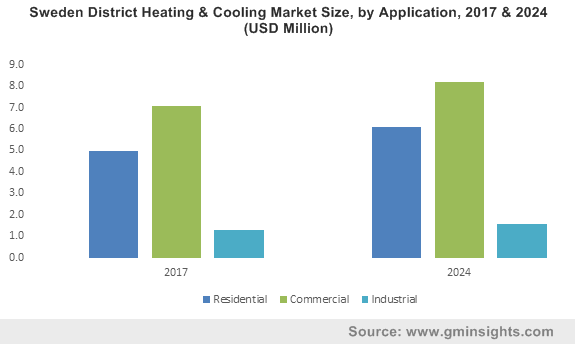A regional rundown of district heating and cooling market: China to emerge as a lucrative investment hub over 2018-2024
Publisher : Fractovia | Published Date : 2018-09-27Request Sample
The rising quest for achieving carbon neutrality has significantly impelled the growth of district heating and cooling market in the recent years. In a bid to attain the stringent carbon and emission control targets, several countries are deploying massive district heating & cooling systems in the growing residential and commercial sectors. Being a centralized system that delivers chilled, hot water, or steam to multiple buildings through a network of pipelines and generates less carbon emissions, the DHC systems are gaining momentum as an effective source over boilers & chillers.
Sweden District Heating & Cooling Market Size, by Application, 2017 & 2024 (USD Million)

As the energy is primarily produced through various sources including CHP (combined heat and power), solar, geothermal, free cooling, absorption cooling and other various sustainable technologies, these systems are energy efficient and much more cost effective. These advantages have significantly fueled the adoption & importance of district heating and cooling systems which in turn have garnered lucrative remuneration. The market’s sheer valuation of USD 200 billion in 2017 stands as a vivid validation to the fact that this business sphere is witnessing massive expansion across myriad geographies.
Rising emphasis toward the construction of green and sustainable buildings standards and codes have significantly complimented the commercial and residential application sectors. Reports claim that the commercial district heating and cooling market will surpass USD 150 billion by 2024, while the residential sector will also witness commendable growth through increasing penetration of the small-scale DHC systems.
A succinct outline of the regional landscape of the global district heating and cooling market
U.S.
The growing awareness and stringent norms toward sustainable & energy efficient space heating & cooling solutions have uplifted the growth of the U.S. district heating and cooling market. Increasing investment toward the development of the residential & commercial establishments along with ongoing government initiatives to promote green technologies have made U.S. a lucrative hotspot for potential investors.
Besides, the U.S. EPA, in 2015, introduced carbon emission regulations under its Clean Air Act to control the release of air pollutants such as SO2, NOx, and CO2 emissions. Such emission control norms also incorporate the NSPS standards to restrict the air pollution from natural gas & coalfired plants. These factors have substantially favored the growth of the U.S. district heating and cooling market, which according to reports is anticipated to outstrip a consumption of over 700 PJ by 2024.
China
The rising industrialization and urbanization trends in the country have majorly favored the regional district heating and cooling market growth. Beyond this, it is also important to mention that in 2013, China recorded its carbon emissions exceeding 10 billion tons, accounting for 28% of the overall global emission & outstripped the combined amount for the United States and EU.
Against this backdrop, the recent growth in the China district heating and cooling market has been very high, given the favorable government backing. Recently, for instance, in 2016, the World Bank granted a USD 100 million loan for the development work of sustainable heating infrastructure across the Hebai province in China. Analysts claim that such initiatives toward large scale deployment of heating & cooling systems will encourage massive product adoption and investment trends. Considering these trends, it has been estimated that the China district heating and cooling industry will alone exceed a consumption of whooping 5000 PJ by 2024.
Singapore is another prominent region which is emerging as an important investment ground in the Asia Pacific district heating and cooling industry. A French firm ENGIE, has recently made it to the headlines for investing nearly USD 80 million in Singapore's district cooling projects to be developed over the coming five years. Reports claim that ENIGE is a renowned player in district heating and cooling industry and its systems are typically 50% more energy efficient than individual cooling solutions, while also generating 50% less carbon emission.
Speaking of ENGIE, it is imperative to mention that the company’s three subsidiaries have together developed a new solution that uses renewable energy to provide heating and cooling for all the connected buildings in Marseille, France. This is expected to reduce the greenhouse gas emissions by as much as 70%.
Given the transforming technology trends across the globe and countless governmental initiatives, the global district heating and cooling industry share is expected to nothing but proliferate in the years ahead. A report compiled by Global Market Insights, Inc., forecasts the annual energy consumption to surpass 19,000 PJ by 2024 and estimates the global valuation to hit an outstanding USD 400 billion mark in the coming six years.